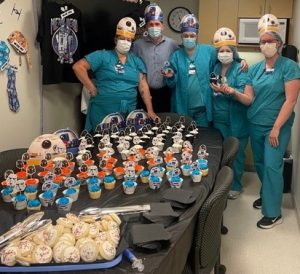When the Operating Room caregivers at Providence St. Peter’s Hospital assembled for a meeting on May 4, they were in for a surprise. Unbeknownst to them, the meeting was actually a birthday party for the team’s two DaVinci robots, now celebrating their first anniversary. The entire group had voted on what to name the pair and given the results, the globally recognized Star Wars Day (May the 4th Be With You) was an appropriate moment to announce the top choices: R2-D2 (main surgery) and BB8 (OR 8 in West Surgery).

The duo replaced a third daVinci robot purchased eight years ago as Providence began shifting toward robotic-assisted surgeries. The move has been a game changer for both patients and surgeons, according to urology specialist Dr. Richard Greene. “Robotic surgery has transformed how we operate,” says Greene. “We’ve gone from procedures with worse outcomes and prolonged recovery to better outcomes and quicker recovery. The robots also allow us to do more complicated operations.”
Within the urology field, Greene and his colleagues use the robots for procedures related to cancer of the prostate, kidneys, ureters and adrenals glands General surgeons use them to repair hernias and colons, and OB/GYNs employ the robots for hysterectomies, cyst removal and reconstructive surgeries. “They increase the services available within the area to better serve the needs of Thurston County and surrounding counties,” says Greene. On an organizational level, having robots strengthens the ability to recruit top-level surgeons.
Each robot comes equipped with heavy arms for attaching instruments. The robots work directly on patients while the surgeon sits at a console and manually maneuvers the instruments. “These arms now have articulating wrists, rather than just an open and closed or back and forth motion,” says Assistant Nurse Manager Lorraine Tveten. “That allows for greater precision.”

Another key factor is 3D ultra-high definition, which provides an improved level of visualization for a complete, magnified view of a patient’s anatomy. Surgeons are better able to preserve structures that need to stay and focus only on what needs to be removed.
“From my perspective, it feels like I’m sitting inside of the patient’s body and using my fingers to operate, instead of using long, telescopic instruments or making a big, open cut into a deep, dark hole,” says Greene. “The robot becomes an extension of the surgeon in that way.”
The two procedures he performs most often are related to prostate cancer and kidney cancer. Before robots, prostate cancer patients spent several days in the hospital and surgeries involved a high risk of needing a blood transfusion, considerable pain and slow recovery as well as complications related to urinary control and sexual function.
All of that has changed, according to Greene. “Robots have completely transformed that scenario,” he explains. “Now you have one night in the hospital and limited pain. I haven’t given a blood transfusion in eight years.” Less pain means less opioid use, a concern for many patients since the national opioid crisis was declared a public health emergency in 2017.

The robots also lower risks for older patients. “I’ve been able to remove kidney tumors from patients in their 70s and 80s, says Greene. “A few years ago, that would have required a big open surgery, which is a lot more difficult to recover from. Now we can remove their cancer, they go home the next day and return to their baseline very quickly. It’s been a dramatic improvement.”
Patients, particularly those who are old enough to remember how things used to be, are grateful for the improved outcomes. They also appreciate having such high-tech tools available in Thurston County rather than having to drive to Seattle or Tacoma for treatment. “There’s less pain and quicker recovery, says Greene. “The last several patients I’ve operated on have been extremely thankful to the nursing team, the robot team and the recovery group. It’s great to be able to offer this to the community.”
Anyone who is interested in exploring robot-assisted surgery should visit the Providence Robotic Surgery page to learn more about what procedures are included and how they might benefit. They can also raise the subject with their primary care provider to learn about their options.
Sponsored



















































